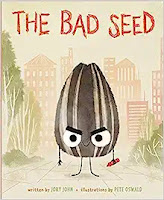I am a big believer in using picture books to teach social skills lessons to my students. Even my older students seem engaged when there is a good story with exciting pictures to look at. One of my favorite books that I use every year is The Bad Seed by Jory John and Pete Oswald.
It is a story about a seed who has had a hard life- a life that hardened them and changed the way they felt about themselves and the world around them. The bad seed exhibits negative behaviors that we sometimes see in our students and children: cutting in line, lying, glaring at other people, etc. In the book, the seed has convinced themselves that they are bad and they will just always be that way. Throughout the book, the seed learns begins to heal through the traumas it has been through, and realizes that it feels good to do kind things such as holding doors open for other people, smiling, saying please and thank you, etc.
Some discussion topics that I used The Bad Seed to discuss are:
-How traumatic events can affect us and the people around us.
-How the way we feel about ourselves can affect behaviors.
-How helping others and being kind actually makes us feel good too.
-How to be easier on ourselves and use affirmations.
We have put together a free lesson that can be used in your home or classroom to teach these themes. It contains discussion questions to use after reading the book, and a worksheet. The worksheet contains a picture of a seed which can be colored. In each section of the seed, have students write a positive attribute about themselves. Teach them to focus on the things they are doing well or their positive attributes, rather than to focus on their negative thoughts about themselves.
You can buy the lesson here on Teachers Pay Teachers











.jpg)
